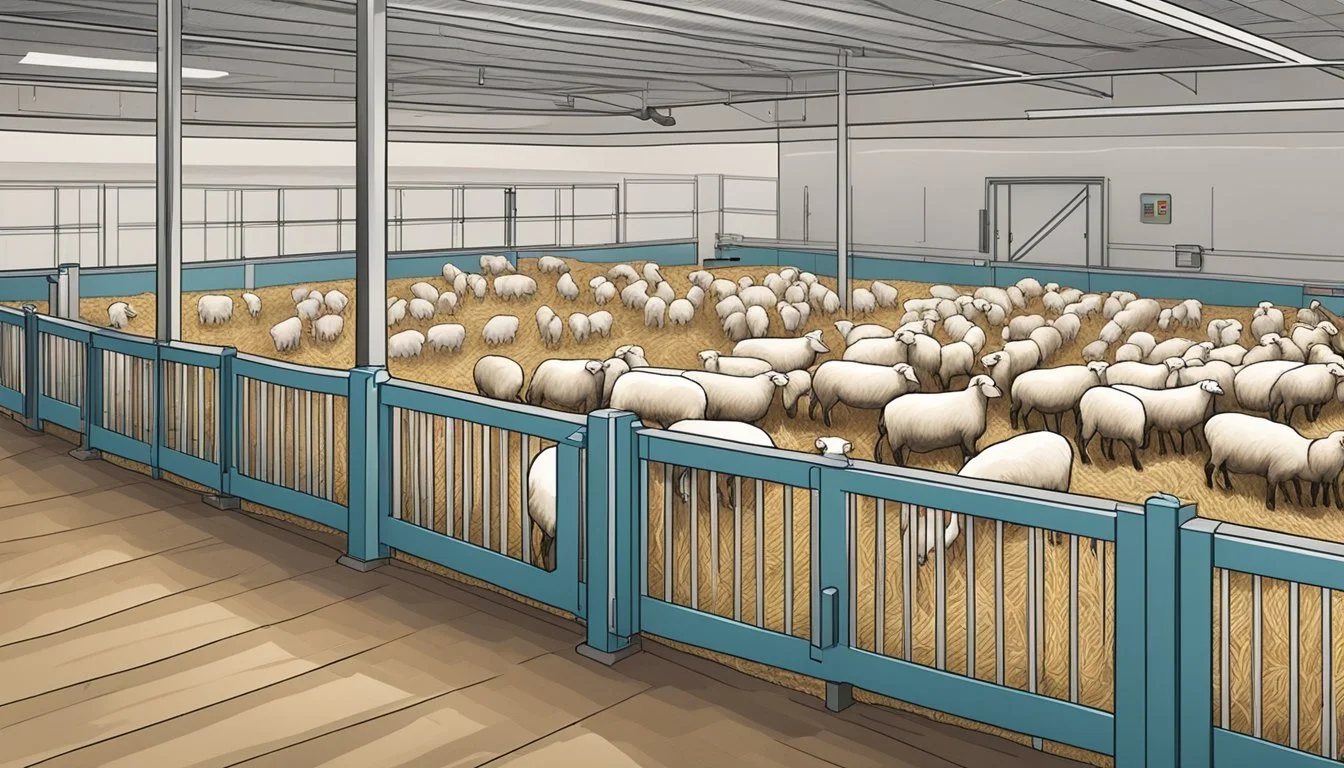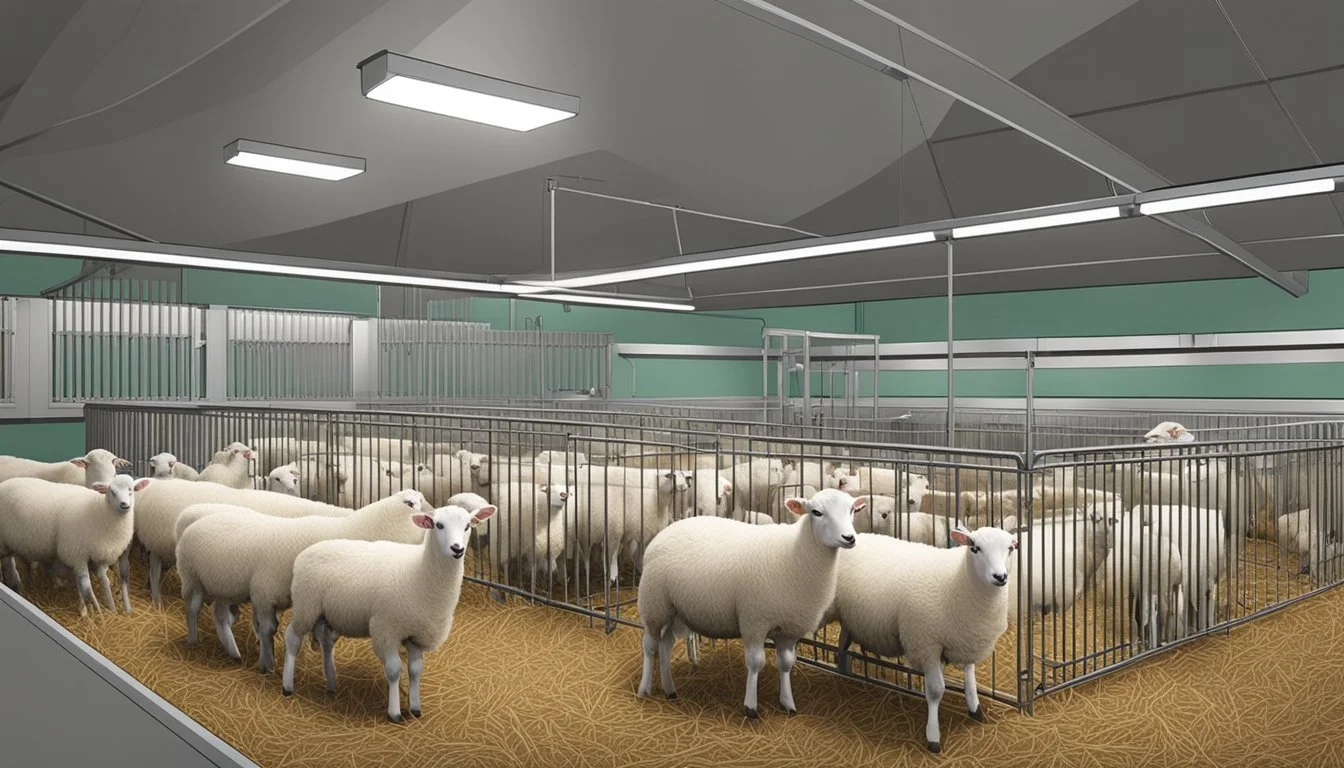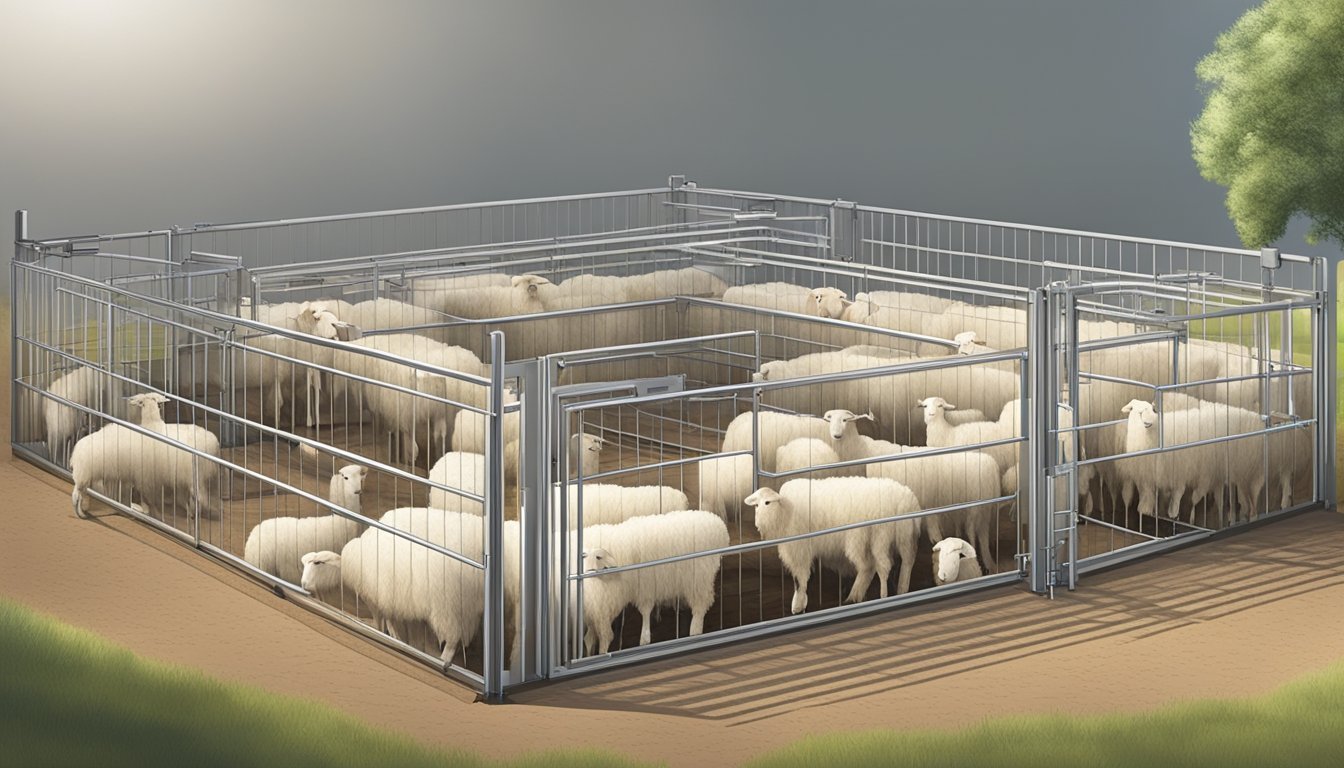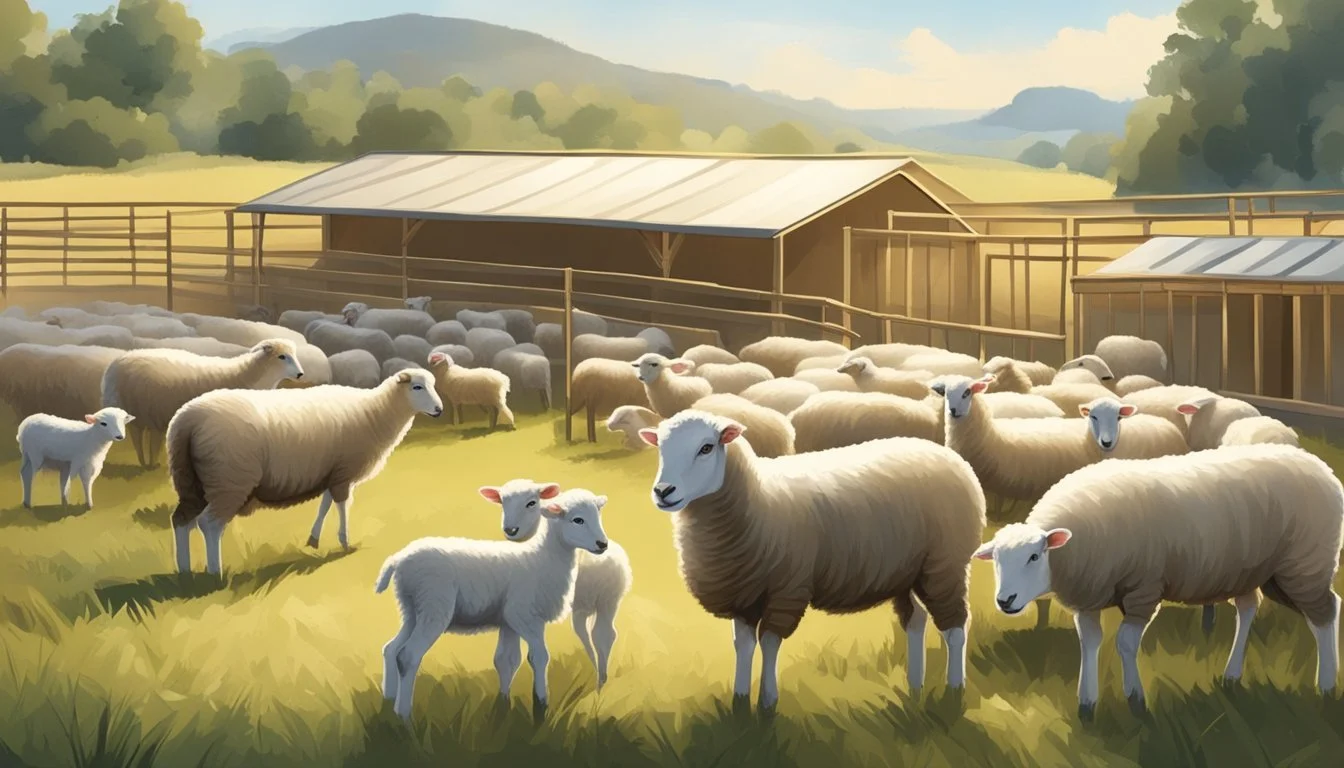The Ultimate Guide to Setting Up a Lambing Pen
Essentials for Ewes and Lambs on Your Homestead
When it comes to successful sheep farming, the birth of new lambs is a critical time that calls for careful preparation and attentive management. The establishment of a lambing pen—an exclusive space for ewes to give birth and nurture their newborns—is an essential step in ensuring the health and survival of the lambs. These pens, often referred to as lambing jugs, provide a controlled environment that facilitates bonding between the ewe and her lambs, as well as allowing for close monitoring and care during the first hours and days of the lambs' lives.
A properly set-up lambing pen is usually a small, separate enclosure within the barn or shelter, measuring around 4 to 5 feet in size for each ewe and her offspring. The sides of the pen need to be at least 3 feet high to prevent drafts and maintain a suitable microenvironment for the lamb's early development. These jugs are generally made from moveable panels, ensuring flexibility and ease of cleaning and disinfection. The setup process includes not only the construction of the pen but also the strategic placement of essentials such as bedding, heating lamps, and feed and water supplies.
Moreover, anticipating the needs of the ewes and their lambs involves a setup that minimizes stress and maximizes comfort. The pen must be readily accessible to the farmer for the monitoring of labor, assistance with birth if necessary, and timely intervention in the event of complications. In this way, farmers can provide the best possible start for their lambs while maintaining the wellbeing of their ewes, laying a strong foundation for the health and productivity of the flock.
Understanding the Lambing Process
When approaching lambing, homesteaders need to be familiar with the ewe’s gestational timeline and the key signals indicating the onset of labor. This understanding enables them to provide timely assistance and ensure a safe birthing process for both the ewes and their lambs.
Gestation and Pregnancy Signs
The gestation period for a sheep typically ranges between 142 to 152 days. As the ewe progresses through pregnancy, certain signs become evident. A swelling udder and an increase in abdominal size are common indicators. In the weeks preceding lambing, a more pronounced vulva and behavioral changes may manifest, such as the ewe showing signs of restlessness and seeking solitude.
Recognizing Onset of Lambing
The onset of lambing is marked by several phases. Initially, the cervix dilates, preparing the birth canal over 12 to 24 hours. One can observe a mucous discharge, which is a clear indication that lambing is commencing. As labor progresses, ewes will exhibit signs of discomfort such as pawing at the ground, laying down and getting back up, and vocalizing. Close observation is crucial since, after the water bags appear, the lamb should be born within 45 to 60 minutes to avoid complications.
Preparation for Lambing
Proper preparation for lambing is critical to ensure the health and safety of both ewes and their lambs. This involves creating a suitable environment, stocking up on essential supplies, and managing the nutrition and healthcare of the ewes throughout the gestation period.
Building and Setting Up the Lambing Pen
The lambing pen, often referred to as a lambing jug, is a private and secure area where a ewe can give birth and bond with her lambs. The gestation period for sheep ranges from 144 to 150 days, and it is advisable to set up lambing pens before this time approaches. These pens should be spacious, measuring at least 5'x5', and well-ventilated to maintain the health of the ewe and her offspring. The structure should be sturdy and free from hazards, ensuring protection from the elements within a lambing shed or designated area.
Essential Lambing Supplies
A well-prepared lambing kit contains:
Obstetrical Gloves: To maintain cleanliness during delivery.
Lamb Puller: For assisting with difficult births.
Iodine Solution: For treating the umbilical cord post-cutting.
Colostrum Replacement: Essential for lambs that cannot nurse.
Heat Lamps: To provide warmth in the lambing pens, especially critical in colder environments.
Towels: For drying off newborn lambs immediately after birth.
Ear Tagger or Livestock Paint: For identifying lambs.
Feeding Bottles and Nipples: In case of the need for supplemental feeding.
Disinfectants and Lubricants: To maintain hygiene during and after birth.
Medical Supplies: Including syringes, antibiotics, and analgesics for health care needs.
Nutrition and Health Care of Ewes
Nutritional management of pregnant ewes is vital to prevent conditions like pregnancy toxemia, especially in the last trimester when most fetal growth occurs. Ewes require an increase in calories and protein to support lamb development and prepare for lactation. Regular vaccinations and disease prevention strategies are crucial to safeguard the flock from common infections. Monitoring the ewe's body condition and providing proper feed and fresh water can directly influence the outcome of the lambing process.
Lambing Season Management
Lambing season requires vigilant oversight and timely intervention to ensure the wellbeing of both ewes and newborn lambs. Effective management during this period is imperative to address any complications that arise and to promote successful births.
Monitoring Ewes and Assisting with Birth
During early and winter lambing seasons, careful monitoring of ewes is essential. Producers should observe their ewes frequently for signs of impending labor, such as udder enlargement, restlessness, and isolation. Assistance with birth may become necessary if a ewe is struggling. In such cases, a person should intervene calmly to help facilitate delivery, ensuring that both the mother and her lamb are safe and secure. Having the right equipment, such as gloves and lubricant, nearby can be crucial for aiding with dystocia, a difficult birthing process.
Addressing Lambing Complications
Complications during lambing, such as dystocia, should be handled promptly to minimize risk to the ewe and her offspring. Producers need to recognize the signs of dystocia, for instance, abnormal presentation of the lamb or prolonged labor. Addressing these complications may range from providing simple manual assistance to calling for veterinary help in severe cases. It is vital for handlers to be prepared with clean facilities, all necessary lambing supplies, and knowledge of lambing techniques to ensure the health and safety of all involved.
Post-Lambing Care
After the birth of lambs, immediate and attentive care is essential to ensure the wellbeing of both the newborn lambs and the ewe. This crucial period involves steps to prevent disease, promote healthy bonding, and ensure that lambs receive vital nutrition for a strong start in life.
Treatment and Care of the Newborn Lamb
Umbilical Cord Care: Once a lamb is born, its umbilical cord should be trimmed to 3-4 inches in length and disinfected with an iodine solution to minimize the risk of infection and tetanus. Typically, a 7% tincture of iodine is recommended.
Colostrum Intake: Newborn lambs should receive colostrum within the first few hours after birth, ideally in the first hour. Ensuring the lamb consumes colostrum is crucial as it contains antibodies that provide immunity and high energy levels critical for the lamb's early life. If the lamb is unable to nurse, a feeding bottle may be used to administer colostrum.
Temperature Regulation: Newborn lambs must be kept warm to prevent hypothermia. A heat lamp may be strategically placed to provide warmth, especially in colder environments.
Health Monitoring: Lambs should be observed closely for signs of illness. Any signs of distress should be addressed promptly, often involving antibiotic treatment under veterinary guidance if there are indications of bacterial infections.
Ensuring Maternal Bonding and Health
Ewe and Lamb Bonding: It's vital for a ewe and her lamb(s) to bond properly in a secure environment. A lambing jug, a small individual pen, is often used to house a ewe and her newborns during the first 24 to 48 hours. This confinement allows the lamb to nurse and bond without interruption or stress.
Monitoring the Ewe: Post-lambing, the health of the ewe should be monitored to ensure recovery from giving birth. Observation for mastitis or any other complications is important for the ewe's long-term health and ability to care for her lamb. A ewe displaying good maternal instincts and behavior is more likely to raise a healthy lamb.
Early identification and treatment of post-lambing issues are imperative to the success of rearing strong and viable lambs. These protective measures lay a foundation for robust growth and development.
Creating a Healthy Environment for Lambs and Ewes
The well-being of lambs and ewes during lambing is foundational, involving careful attention to hygiene and temperature control, as well as optimal nutrition and supplementation strategies.
Maintaining Cleanliness and Warmth
In the lambing pen, cleanliness is crucial to prevent disease and promote health. Prior to lambing season, thorough cleaning of the pen with a disinfectant is essential. After each ewe and her lambs vacate, remove soiled bedding and sanitize the area before introducing another ewe. Bedding should consist of clean, dry straw or hay, which provides insulation and comfort.
Heat lamps need to be safely secured away from flammable bedding but close enough to provide essential warmth, especially for newborn lambs, who are prone to hypothermia. Adjust the placement of lamps to create a temperature gradient, allowing lambs to move towards or away from the heat source as required.
Managing Nutrition and Supplementation
Nutrition directly impacts the health and recovery of ewes post-lambing and the growth of lambs. Ewes require high-energy diets to support lactation. Ensure they have access to quality hay or forage and a balanced grain mix if necessary.
Supplementation should cater to the needs of both the ewes and lambs. For ewes, provide supplements rich in energy and vitamins, as well as essential minerals like calcium and phosphorus. For lambs, early colostrum intake is critical; they should receive adequate colostrum — the first milk rich in antibodies — within the first few hours of life to boost their immune systems.
Consistent access to clean, fresh water is indispensable for both ewes and lambs. Water intake is vital for ewes' milk production and overall health. Lambs usually begin to drink water within a few days of birth. The water sources should be checked and refilled multiple times per day to ensure cleanliness and availability.
Common Health Issues and Their Prevention
In setting up a lambing pen, it's crucial to manage potential health issues proactively. By understanding and preparing for infections and environmental hazards, farmers can ensure the welfare of both ewes and lambs.
Infections and Disease Management
In a lambing pen, both ewes and newborn lambs are susceptible to a range of infections and diseases, but proactive management can prevent many common conditions. Colostrum intake within the first hour of life is essential to transfer antibodies to lambs, helping their immune systems combat infection. Farmers should stock antibiotics as prescribed by a veterinarian to address any outbreaks promptly.
Disease: Navel ill, Prevention: Dip navel in iodine solution at birth, Treatment: Antibiotics if infected.
Disease: Pneumonia, Prevention: Avoid drafts, vaccinate ewes, Treatment: Antibiotics and warmth.
Disease: Scours, Prevention: Ensure proper nutrition, hygiene, Treatment: Electrolytes, antibiotics if bacterial.
Hygiene is paramount, and lambing pens should be cleaned and disinfected between each use to reduce the risk of disease spread. Farmers must monitor for signs of distress or illness, such as lethargy or lack of appetite, to catch issues early.
Preventing Hypothermia and Other Hazards
Newborn lambs are particularly vulnerable to hypothermia, which can occur rapidly in cold, wet conditions. Lambing pens should offer ample warm, dry bedding, and a heat source such as a heat lamp when necessary. Farmers should also provide shelter from drafts and keep the pen environment at a steady temperature.
Preventing chill extends beyond temperature control; farmers must also safeguard lambs against predators by ensuring robust fencing and possibly using guardian animals. Additionally, monitoring weather forecasts and preparing for adverse conditions is essential in safeguarding the health of the flock.
Lastly, ewes require sufficient nutrients and calories to support lactation and maintain their own health, which, in turn, benefits the lambs. Adequate food and water for the ewes, as well as easy access for the lambs, contribute to overall herd health.
Lambing Pen Design and Equipment
Setting up an effective lambing pen requires a strategic use of space and the right selection of tools and equipment that contribute to the safety and comfort of ewes and their newborn lambs.
Optimizing Space and Facilities
The layout of a lambing pen is crucial for maximizing efficiency while ensuring the well-being of ewes and lambs. Confinement areas, typically known as "lambing jugs," should measure approximately 4x4 feet or 5x5 feet, providing ample room for the ewe and her lambs without occupying excessive space in the barn. Movable panels are recommended for constructing these pens, as they offer flexibility in size and can be easily set up or disassembled. An indoor wall can serve as one side of the pen, with the lengths of multiple pens running alongside the feeding alley to optimize space utilization.
Sides: 2 of 5′ and 1 of 4′
Height: At least 3′
Space: 16-25 square feet
Equipment and Tool Requirements
When preparing for the lambing season, a comprehensive list of lambing equipment is necessary for efficient management. Key items include:
Ear taggers and small tags for lamb identification.
Livestock paint for marking.
Towels or rags for cleaning newborn lambs.
Scissors for umbilical cord trimming.
Additionally, prevention drops for common respiratory issues can be vital. The pen should also have a provision to keep these tools organized and easily accessible. By having all required tools at the ready, farmers can ensure a smooth and sanitary lambing process, which is essential for the health and well-being of both the ewes and their offspring.
Lambing Operational Practices
Proper management during lambing is critical for the health and success of both ewes and their lambs. Ensuring accurate record-keeping and establishing standardized handling and tagging of lambs are among the essential operational practices.
Effective Record Keeping
Accurate record-keeping is vital in managing a lambing operation effectively. It involves tracking the body condition of ewes throughout their pregnancy to anticipate and prepare for their lambing needs. Moreover, maintaining thorough records can help optimize the health and productivity of the flock. Record details such as:
Ewe identification
Breeding dates
Expected lambing dates
Lamb birth weights
Use a table format like the one below to organize and easily access the data:
Ewe ID 001: Breeding Date - 2023-10-15, Expected Lambing Date - 2024-03-09, Lamb Birth Weight - 8 lbs
Ewe ID 002: Breeding Date - 2023-10-18, Expected Lambing Date - 2024-03-12, Lamb Birth Weight - 7.5 lbs
Handling and Tagging of Lambs
Immediately following birth, each lamb should be handled with care to ensure that it bonds with its mother and begins feeding. Tagging is an essential step in the management of the flock. It enables farmers to track the lambs throughout their lives. The use of an ear tagger allows for quick and efficient tagging without causing undue stress to the animal. Tags should be small enough not to inhibit the lamb yet durable to remain in place throughout its life. Include critical information on the tag such as:
Lamb’s ID number
Date of birth
Ewe’s ID number
During tagging, gently restrain the lamb to minimize stress and to assure safe application of the tag. The time immediately after birth is most suitable for tagging, ensuring minimal chance of misidentifying the lambs.
Aftercare and Next Steps
After the lambing process, the well-being of both the ewe and her lamb hinges on diligent aftercare and forward-thinking management. This crucial period sets the foundation for the lamb's health, growth, and the ewe's recovery, as well as plans for future lambing seasons.
Weaning and Follow-up Care
A pivotal step in lamb development is weaning, typically initiated around 2 to 3 months of age. During this phase, it's essential to monitor the lamb's health and growth, ensuring they transition to solid feed effectively. Proper nutrition post-weaning promotes steady growth and reduces stress.
Follow-up care includes:
Bonding: Encourage strong ewe-lamb bonding immediately after birth to ensure lambs receive adequate colostrum.
Vaccinations: Adhere to a vaccination schedule to protect against common diseases. Consult with a veterinarian for the appropriate timing and vaccines for your flock.
Regular Checks: Monitor for growth milestones and any signs of illness.
Planning for Future Lambing Seasons
Effective planning is key to sustaining a productive flock. Reflect on the previous lambing season to identify areas of success and opportunities for improvement. Key considerations for future planning include:
Breeding Records: Accurate breeding records help predict future lambing dates and prepare accordingly.
Facility Enhancements: Evaluate the lambing pen setup and make adjustments based on observed needs and challenges.
Health Protocols: Update health management strategies, including vaccination schedules and nutrition plans, to optimize the ewes' condition for the next breeding season.
Ruminating on Successes: Note successful strategies and repeat them in the upcoming seasons.








